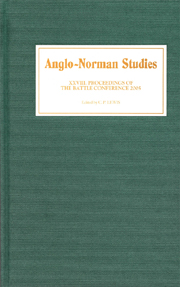Book contents
- Frontmatter
- Contents
- LIST OF ILLUSTRATIONS, MAPS, AND TABLES
- EDITOR'S PREFACE
- ABBREVIATIONS
- Inside the Anglo-Norman Family: Love, Marriage, and the Family (R. Allen Brown Memorial Lecture)
- Land Tenure and Royal Patronage in the Early English Kingdom: A Model and a Case Study
- The Homilies of a Pragmatic Archbishop's Handbook in Context: Cotton Tiberius A. iii
- Robert de Vaux and Roger de Stuteville, Sheriffs of Cumberland and Northumberland, 1170–1185
- The Common Steeple? Church, Liturgy, and Settlement in Early Medieval Lincolnshire
- The Question of Masculinity in William of Malmesbury's Presentation of Wulfstan of Worcester
- Share and Share Alike? Bishops and their Cathedral Chapters: The Domesday Evidence
- Dunstan and Monastic Reform: Tenth-Century Fact or Twelfth-Century Fiction?
- Domesday Now
The Common Steeple? Church, Liturgy, and Settlement in Early Medieval Lincolnshire
Published online by Cambridge University Press: 12 September 2012
- Frontmatter
- Contents
- LIST OF ILLUSTRATIONS, MAPS, AND TABLES
- EDITOR'S PREFACE
- ABBREVIATIONS
- Inside the Anglo-Norman Family: Love, Marriage, and the Family (R. Allen Brown Memorial Lecture)
- Land Tenure and Royal Patronage in the Early English Kingdom: A Model and a Case Study
- The Homilies of a Pragmatic Archbishop's Handbook in Context: Cotton Tiberius A. iii
- Robert de Vaux and Roger de Stuteville, Sheriffs of Cumberland and Northumberland, 1170–1185
- The Common Steeple? Church, Liturgy, and Settlement in Early Medieval Lincolnshire
- The Question of Masculinity in William of Malmesbury's Presentation of Wulfstan of Worcester
- Share and Share Alike? Bishops and their Cathedral Chapters: The Domesday Evidence
- Dunstan and Monastic Reform: Tenth-Century Fact or Twelfth-Century Fiction?
- Domesday Now
Summary
This modest, interdisciplinary paper is a report on fieldwork undertaken a decade ago in Lincolnshire, whilst the authors were collecting material for the Corpus of Anglo-Saxon Stone Sculpture for that county. On most maps of Anglo-Saxon remains in England, Lincolnshire is thickly spread with symbols marking churches. This exceptional density is mostly due to the survival in considerable numbers of church towers of the characteristically simple, tall, unbuttressed type exemplified in a complete form by St Peter-at-Gowts or St Mary-le-Wigford in the southern suburb of Lincoln (Fig. 1). They are frequently said to be late Anglo-Saxon in date and thus the Corpus had a legitimate interest in their architectural sculpture, notably the distinctive capitals in their bell-chamber openings. However, we have become interested in the broader meaning of the sculptures, in the towers themselves, and in the settings of the churches to which they were attached. This paper focuses on these more general issues and is offered in advance of publication of the book that records our results in detail.
Architecture and Obsequies
Our study includes sixty towers in all, which have been considered to be relevant to this discussion in the past; and we have discussed all but nine of these in detail. These nine – Barnetby-le-Wold, Brattleby, Claxby-le-Wold, Greetwell, Irby-on-Humber, Laceby, Lincoln St Benedict, Normanby-le-Wold, and Stoke Rochford (forming Group H in Table 1) – appear wholly later in date than the mid twelfth century.
- Type
- Chapter
- Information
- Anglo-Norman Studies 28Proceedings of the Battle Conference 2005, pp. 103 - 123Publisher: Boydell & BrewerPrint publication year: 2006



